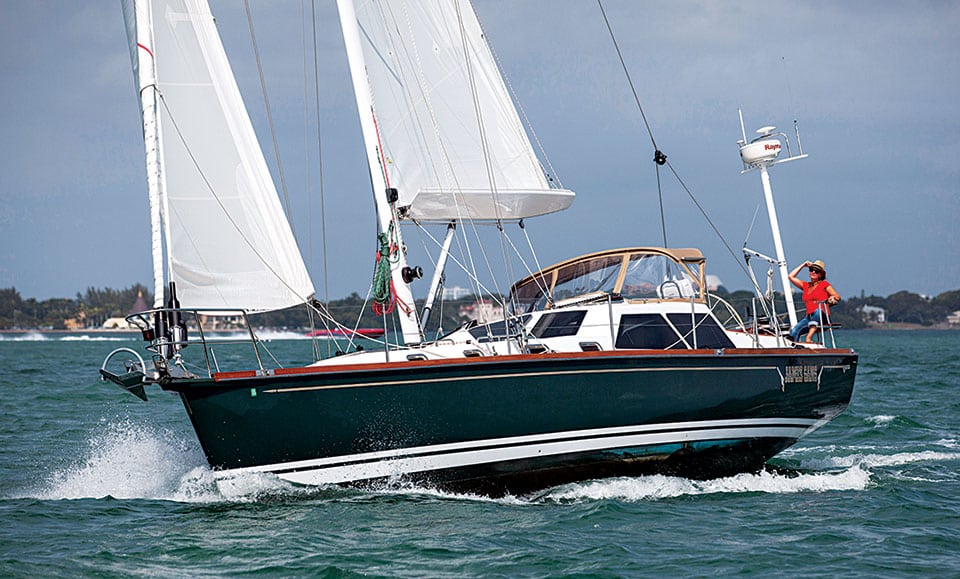
Tartan 4700 Sailing
Tartan Yachts has long had a knack for wrapping fine-sailing, bluewater-capable hulls around creature-friendly, wood-filled interiors that I’d describe as being at the same time elegant and homey. Its latest, the Tartan 4700, which was introduced last winter in Miami, is a sailboat that I wish I could simply call “home.”
The Tartan 4700’s design stems from the builder’s willingness to embrace a host of options and a customer’s wish for something in between the other two big boats in the Tartan range, the 4300 and 5300. Like its slightly smaller sibling, the 4700 — designed by Tim Jackett and the company’s design team — has an aft cockpit deck layout, and like its big sister, a raised cabin house with oversize ports that create a roomy and bright interior with panoramic views of the great outdoors.
| _ |
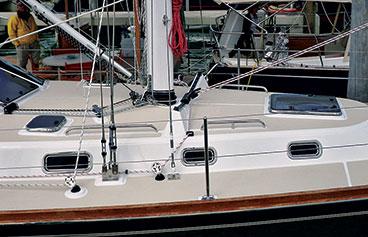
_| |_Tight sheeting angles and clear side decks are made possible by chainplates set against the cabin top. Click here for a full photo gallery of the Tartan 4700. _|
And like all recent members of the Tartan family, the 4700 sports what the company calls its Cruise Control Rig, comprising a carbon-fiber mast, twin headsails (the working jib and reacher are set up solent style) and a sail- handling-friendly carbon pocket boom. With the self-tending, hydraulically furled jib rolled out and the main set, the Edson rack-and-pinion steering was butter smooth as we sliced to windward through a mild chop on Biscayne Bay. The speedo hovered in the 7-knot range in breeze that wavered between 12 and 17 knots true.
With a simple turn of the wheel, we tacked through slightly less than 90 degrees and then held our speed as we bore off to a beam reach. Seated, I found the raised cabin top limited my visibility straight ahead, but perched on the leeward rail, I had good sight lines of the sails and our surroundings. With the breeze building, we decided it prudent to leave the light-air, off-wind reacher furled for another day.
Wide side decks and stays anchored next to the cabin top allow for both tight sheeting angles and easy movement forward. Underfoot, the boat felt solid as a rock, thanks no doubt to the lead fin keel and 9,750 pounds of ballast below.
In the cockpit, a chartplotter pod sits atop the oversize helm station that also houses headsail furling controls, a bow thruster joystick, a compass, engine instruments, and electrical switches for things like navigation and cockpit lighting. Forward of the helm, a fold-down teak cockpit table opens up for dining. Cockpit coamings are high enough to provide good back support, and the benches are long enough for stretching out for a nap. The teak sole I found to be easy on the eyes and sure underfoot.
| _ |
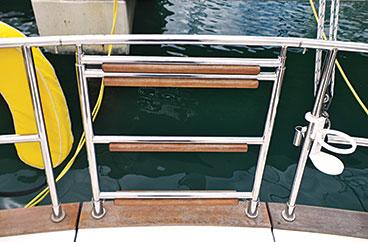
| |_The fold-down swim platform in the transom includes a boarding ladder that’s incorporated in the rear pulpit when the platform is raised and ready for sailing.|
At a dock or at anchor, the boat is easy to board via the fold-down swim platform that’s set in the slightly reversed transom. Indicative of the many well-thought-out touches engineered into the boat is the swim platform that’s incorporated into the tubing of the stern pulpit.
Belowdecks, cherry hardwood and paneling abound, offset on the boat I sailed by light gray upholstery and white expanses of fiberglass. The companionway steps leading below are sized right for sound footing, and the narrow passage down should be quite secure in any sort of sea. I did find a lack of headroom under the companionway hatch as I reached the last step, but I’d guess it’s something I could get used to.
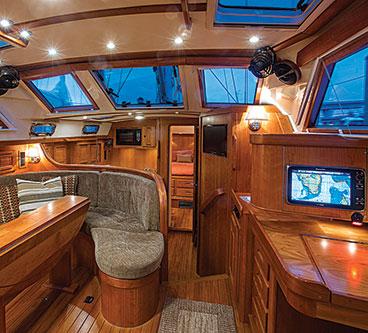
| |Fine joinery is found throughout the main saloon and the galley, which is down a step and tucked in against the forward bulkhead.|
The main saloon is laid out around an attractive drop-leaf table and L-shaped couch to port and the nav station and desk to starboard. Moving forward you step down into a spacious galley with tons of storage space and all the appliances a chef would need to whip up a feast. A cabin with bunk beds occupied the space to starboard of the galley on this boat, but owners could opt for other uses, such as a pantry or office, depending on their needs.
Forward of that is the cabin I’d choose, if I were the owner. There’s plenty of room to move about the centerline island queen berth, lots of places to stow belongings, and a head and roomy shower.
A third cabin is all the way aft. It too has a queen berth, but I thought the headroom above it was a bit cramped. And just above where the starboard pillow would rest, there’s an intrusive box covering the steering mechanism. Visitors or kids, though, would have few complaints about the accommodations.
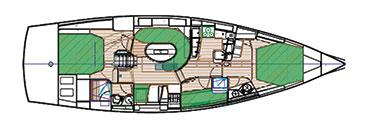
In laying up the infused epoxy foam-cored hull, Tartan used a clear gelcoat, which among other attributes allowed the structure to be inspected for any voids. An owner can then choose the color he wants from the paint shed. The deck is a balsa-cored, fiberglass and epoxy sandwich with solid aluminum plates embedded wherever hardware will be mounted. Holes are then drilled and tapped for fittings. Throughout, the workmanship appeared top-notch.
Overall, the 4700 was a hoot to sail, beautiful to look at and comfortable as could be. It’s surely a boat to take voyaging, and as I said at the start, it’s one I’d gladly call home when I got there.
Click here to see more photos of the Tartan 4700.
| Tartan 4700 Specifications | ||||
| LOA | 46’ 10” (14.27 m.) | SEA TRIAL | ||
| LWL | 39’ 6” (12.04 m.) | Wind Speed | 12 to 17 knots | |
| Beam | 14’ 10” (4.52 m.) | Sea State | 1 to 2 feet | |
| Draft | 6’ 3” (1.91 m.) | Sailing | ||
| Sail area (reacher) | 1,081 sq. ft. (100.5 sq. m.) | Closehauled | 6.5 to 7.2 knots | |
| Ballast | 9,750 lb. (4,423 kg.) | Reaching | 7.4 knots | |
| Displacement | 28,000 lb. (12,701 kg.) | Motoring | ||
| Ballast/D | .35 | Cruise (2,700 rpm) | 6.8 knots | |
| D/L | 203 | Fast (3,200 rpm) | 7.8 knots | |
| SA/D | 18.8 | |||
| Water | 200 gal. (757l.) | |||
| Fuel | 120 gal. (454 l.) | |||
| Holding | (2) 30 gal. (2) (114 l.) | |||
| Mast height | 68’ 00” (20.73 m.) | |||
| Engine | 75 hp Volvo with sail | |||
| hp, shaft drive | (110 drive optional) | |||
| Designer | Tim Jackett, Tartan design team | |||
| Price | $925,00 |
Mark Pillsbury is CW’s editor.
Click here to see more Tartan Yachts.
Tartan Yachts
440-392-2628
www.tartanyachts.com








